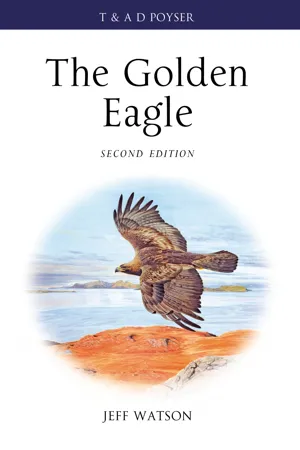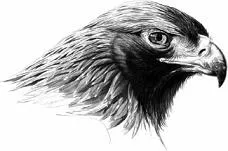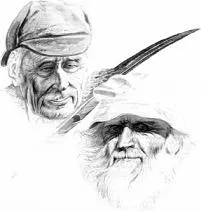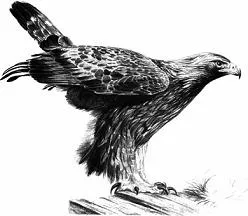
- 464 pages
- English
- ePUB (mobile friendly)
- Available on iOS & Android
eBook - ePub
The Golden Eagle
About this book
This comprehensive monograph is a second edition of one of the most popular Poyser monographs.
It covers all aspects of this spectacular eagle's biology and ecology, including a full review of the literature and incorporating the considerable body of research on the species since the publication of the first edition in 1997. The late Jeff Watson was one of Scotland's foremost eagle experts, with more than 20 years of research on the birds; following Jeff's untimely death, the book is being completed by his colleagues Des Thompson and Helen Riley.
Scottish studies provide the foundation for a treatment that also includes up-to-date information from work in North America, continental Europe and elsewhere. This global view allows fascinating insights into the species' relationships with a variety of different habitats and leads to many new and important conclusions regarding its ecology.
This highly readable and authoritative account is the standard reference on the species, both in Scotland and elsewhere in the world. The text is enriched with many superb pictures of this majestic bird and additional wash landscapes capture the very special atmosphere of Scotland's Golden Eagle country.
It covers all aspects of this spectacular eagle's biology and ecology, including a full review of the literature and incorporating the considerable body of research on the species since the publication of the first edition in 1997. The late Jeff Watson was one of Scotland's foremost eagle experts, with more than 20 years of research on the birds; following Jeff's untimely death, the book is being completed by his colleagues Des Thompson and Helen Riley.
Scottish studies provide the foundation for a treatment that also includes up-to-date information from work in North America, continental Europe and elsewhere. This global view allows fascinating insights into the species' relationships with a variety of different habitats and leads to many new and important conclusions regarding its ecology.
This highly readable and authoritative account is the standard reference on the species, both in Scotland and elsewhere in the world. The text is enriched with many superb pictures of this majestic bird and additional wash landscapes capture the very special atmosphere of Scotland's Golden Eagle country.
Frequently asked questions
Yes, you can cancel anytime from the Subscription tab in your account settings on the Perlego website. Your subscription will stay active until the end of your current billing period. Learn how to cancel your subscription.
At the moment all of our mobile-responsive ePub books are available to download via the app. Most of our PDFs are also available to download and we're working on making the final remaining ones downloadable now. Learn more here.
Perlego offers two plans: Essential and Complete
- Essential is ideal for learners and professionals who enjoy exploring a wide range of subjects. Access the Essential Library with 800,000+ trusted titles and best-sellers across business, personal growth, and the humanities. Includes unlimited reading time and Standard Read Aloud voice.
- Complete: Perfect for advanced learners and researchers needing full, unrestricted access. Unlock 1.4M+ books across hundreds of subjects, including academic and specialized titles. The Complete Plan also includes advanced features like Premium Read Aloud and Research Assistant.
We are an online textbook subscription service, where you can get access to an entire online library for less than the price of a single book per month. With over 1 million books across 1000+ topics, we’ve got you covered! Learn more here.
Look out for the read-aloud symbol on your next book to see if you can listen to it. The read-aloud tool reads text aloud for you, highlighting the text as it is being read. You can pause it, speed it up and slow it down. Learn more here.
Yes! You can use the Perlego app on both iOS or Android devices to read anytime, anywhere — even offline. Perfect for commutes or when you’re on the go.
Please note we cannot support devices running on iOS 13 and Android 7 or earlier. Learn more about using the app.
Please note we cannot support devices running on iOS 13 and Android 7 or earlier. Learn more about using the app.
Yes, you can access The Golden Eagle by Jeff Watson,Keith Brockie in PDF and/or ePUB format, as well as other popular books in Biological Sciences & Zoology. We have over one million books available in our catalogue for you to explore.
Information
CHAPTER 1
Introduction
Introduction

“A moment of excitement—an eagle glided low over the high plateau in almost level flight. It flew on northwards without a wingbeat, making the slightest shimmy of its great wings as it turned and vanished behind the projecting scree of Carlin’s Cairn”.
Donald Watson, writing about a day at Corserine
in the Galloway hills, July 1987.
in the Galloway hills, July 1987.
THE proposal to write a monograph on the Golden Eagle was first put to me more than 20 years ago. On numerous occasions since then I have wondered whether the task was too great. Year by year, new and exciting work on Golden Eagles is being carried out and published, especially in North America but also in Europe and elsewhere. Inevitably, statements that I make here will be challenged, tested and enhanced by new research. That is as it should be, and I hope this book will be a catalyst in the process as well as a source of reference for those who share my passion for this splendid bird.
SCOPE OF THE BOOK
This account of the Golden Eagle is founded on work in Scotland, where I have studied the bird for over 25 years. I have also been privileged to observe the species in several other countries in Continental Europe, in North America and in Japan. As I indicate in the Acknowledgements, I am indebted to many people, and especially to members of the Scottish Raptor Study Groups, for allowing me to use their information to extend my own work. My personal interest in the bird has been focused on two main fields: population ecology (why eagle numbers and breeding success vary from place to place) and human impacts on eagles. Consequently, these themes recur regularly throughout this book. At the same time I have attempted a fairly comprehensive account of the general behaviour and ecology of the species, drawing on the extensive global literature for comparative material and to fill in gaps where work has not been done in Scotland. The end result is that I have sought to place the findings from Scotland in a wider context. I believe this to be helpful for those who study Golden Eagles in Scotland, where, in my judgement, the condition of Golden Eagle habitat is far from healthy—so serious is the degradation through overgrazing and other current land use practices. I also see benefits in this extensive approach for researchers in other countries. For these people, the results of research are often encountered in the necessarily dry scientific literature. As such it is frequently difficult to gauge the wider context within which that research resides. For those who do not know Scotland particularly well, I have sought to define the ‘sense of place’ occupied by Golden Eagles in the landscape of the Scottish Highlands and Islands.
In a number of respects the role of Golden Eagles can be better understood by comparing their ecology and behaviour with that of closely allied species. To this purpose I have embraced information from research on other members of the genus Aquila where this seems appropriate or especially illuminating. For those who are unfamiliar with Aquila eagles I have included a short introduction to the other members of the genus in Appendix 1. Some readers may find it helpful to refer to that section after reading the introduction to the Golden Eagle given in Chapter 2. In several subsequent chapters I have included material reflecting on the similarities and contrasts between the Golden Eagle and its congeners. I am especially indebted here to the impressive work done by Valerie Gargett and her team on Verreaux’s Eagles in Africa, and to the detailed studies of the Spanish Imperial Eagle by Miguel Ferrer and his colleagues in southwest Spain.
PERSONAL REFLECTIONS
My interest in birds began more than 40 years ago when I was a young boy growing up in the heart of Galloway in southwest Scotland. My father’s enthusiasm for birds, both as a painter and as a studiously careful observer of bird behaviour, was an ever-present influence. Add to this the steady flow of ornithologists through our home and it was perhaps inevitable that birds would figure large in my later life. The 1960s was an exciting time for young minds whose level of environmental consciousness had been raised. I can recollect the powerful influence of Rachel Carson’s Silent Spring (Carson 1962) and the urgency of the debate as Derek Ratcliffe began to unravel the puzzle of breeding failure among our local Peregrines, and the causal links with organochlorine pesticides. Even as the pesticide battle was being won in the late 1960s, I can recall Derek’s commitment transferring to a new cause. Long before others were prepared to concede there was a serious issue at all, he had recognised the damaging ecological consequences of the uncontrolled afforestation of the uplands of Britain. This, too, was very close to us in rural Galloway, where month by month we watched great tracts of the hill country planted up with monocultures of exotic conifers.
My earliest memory of Golden Eagles is with my father, watching a pair as they soared effortlessly high over a nest site not far from the well-known local landmark of Murray’s Monument. This was the first eagle site in the Galloway hills to be recolonised after the relaxation from human persecution brought about by the 1939–45 war. It is a sad irony that during the 1980s this territory was then the first to be abandoned. The disappearance of the pair here was almost certainly due to the growth of the conifer forests that were planted during the 1950s over huge areas of the birds’ previous range, and the consequent loss of crucial open hunting grounds.
My first contact with Golden Eagles in the Scottish Highlands was in the 1970s when I studied zoology at Aberdeen University. If environmental consciousness was raised in the 1960s, by the 1970s it was positively overflowing. My interest in raptors, and in the many unanswered questions of population ecology, was encouraged by many teachers, but perhaps most of all by George Dunnet, who was then Professor of Natural History at Aberdeen. The publication of Ian Newton’s Population Ecology of Raptors in 1979 was, for anyone interested in birds of prey at that time, an event of enormous significance. I still regularly turn to this book both for its clarity of expression and for its unending source of reference material. It was shortly after this, in the early 1980s, that I was given the opportunity to work full-time on Golden Eagles. For nearly five years Stuart Rae and I had the task of trying to disentangle the various impacts of land use change on Golden Eagles in the Scottish Highlands. Although my full-time work on the Golden Eagle came to an end in 1985, I have maintained a close personal interest in the bird ever since.
The Highlands and Islands of Scotland have provided the inspiration for generations of eagle enthusiasts. In the first decade of this century H. B. MacPherson secured the first and quite remarkable sequence of photographs of Golden Eagles, taken at a nest in the central Highlands (MacPherson 1909). Then came the investigations of Seton Gordon, the grand old man of Scottish eagle studies, ably assisted by his wife, Audrey. Their impressive observations on Golden Eagle behaviour were accumulated during more than half a century of field study and culminated in the publication of two seminal books, Days with the Golden Eagle (Gordon 1927) and The Golden Eagle, King of Birds (Gordon 1955). Over 50 years later, it is a testament to the quality of observation and research underpinning the latter book that it remains today the authoritative monograph on the species. During the 1950s and 1960s a growing band of eagle watchers in Scotland was spearheaded by Adam Watson, Leslie Brown, Charlie Palmar and Pat Sandeman. Adam Watson’s observations on eagles in Deeside began in the 1940s and continue to this day; he is is now unquestionably the longest continuous recorder of nesting Golden Eagles anywhere in the world.
There are certain personal qualities I tend to associate with eagle enthusiasts, and I would guess that most of the early Scottish workers had these to some degree. The first of these qualities is tenacity, and a preparedness to pursue their interest despite the frustration caused by the elusiveness of the birds they study and the frequently inclement conditions and difficult terrain in which they work. Then there is a single-mindedness of purpose and a related tendency to be at ease with solitude. Dedicated ‘eagle people’ are unlikely to be the most gregarious folk on earth. From these qualities, perhaps reinforced by the daily experience of eagle field work, can emerge an understandable degree of intolerance, particularly towards our thoughtlessness and misuse of the natural world. To an extent I probably recognise all these traits in myself.
A GLOBAL PERSPECTIVE
One of the most revealing aspects of writing this book has been the opportunity to correspond and share experience with eagle workers in many other parts of the world. Some 30 or 40 years ago it was probably true that much of the leading thinking and research on the population ecology of raptors was being done in Britain. This is no longer the case. The reason is, in part, a lamentable decline in the commitment of state funds for all types of ecological research in Britain since the late 1970s. As this process has continued, so other countries have maintained or enhanced their research investment. It is perhaps not surprising that much of the ground-breaking work on population ecology is now being done in the United States. It is my impression also that the level of commitment in Britain to ecological research, within my own particular field of interest, has now been overtaken in such diverse places as Spain, Finland and Switzerland. While I can only commend the progress that has been achieved in these places, it is a matter of regret that the opportunities for young researchers in Britain to contribute to this revitalised global effort are increasingly few.

Two of the pioneers of Golden Eagle work in Scotland, Seton Gordon (top) and Adam Watson.
The wealth of information from many other parts of the world makes it especially important to provide a global perspective to this book. Nevertheless, this has not been without its challenges. The sheer volume of literature on Golden Eagles and the other Aquila eagles was, even by the early 1980s, quite prodigious, as shown by the impressive bibliography produced by Le Franc & Clark (1983). Since that work was published, the literature has expanded rapidly. In the United States the study of Golden Eagles at Snake River Canyon in Idaho, led by my friends Mike Kochert and Karen Steenhof, has been a major contributor. I was fortunate enough to visit the Snake River project at Boise in the spring of 1991. Along with the imposing quality of the research being done there, I left with an abiding impression of the sheer number of people involved in raptor work. I was only half joking when I told friends on my return that there were more people earning a living out of raptor work in the town of Boise, Idaho, than there were raptor biologists in the whole of Britain! Over the border in Canada, Gary Bortolotti has contributed important publications on Golden Eagles alongside his work on Bald Eagles and other raptors. Exciting work on Golden Eagles is being carried out by Carol Mclntyre within the quite different landscape of subarctic Alaska.
One of the richest countries in Europe for breeding raptors is Spain. Here, there has been substantial work on the status and general ecology of Golden Eagles by Bernardo Arroyo and Carmelo Fernández, among others. Further south in Spain, Miguel Ferrer has given research into the endangered Spanish Imperial Eagle an elevated place in the scientific literature, and he distilled this into impressive monographs (Ferrer 1993a, 2001). The first international colloquium on the Golden Eagle in Europe was held at Arvieux in the French Alps in 1987 under the guidance of Samuel Michel. Out of this came an invaluable resumé of Golden Eagle status, and of contemporary research priorities across Europe (Michel 1987). Heinrich Haller has extended the knowledge of Golden Eagles in the Swiss Alps, and he was one of the first in Europe to make use of the new technology of satellite telemetry to document Golden Eagle ranging behaviour. Major contemporary Golden Eagle research in Scotland is being done on several fronts. I must highlight the conservation framework developed by Phil Whitfield and colleagues (Whitfield et al. 2008a), the uses being made of radio-telemetry and, more recently, satellite tagging by Mike McGrady, Roy Dennis and others, and the donation of Golden Eagle chicks to Ireland to support the reintroduction project there; all of this is reported later in the book. Across the North Sea, in Scandinavia, work on Golden Eagles in Norway has been carried out by Gunnar Bergo and others, while Martin Tjernberg has continued to add new insights from the work he began in Sweden in the 1970s. An exciting recent development has been the increased volume of research on raptors in Eastern Europe, much of this with the support and encouragement of the irrepressible Bernd Meyburg. Of special note are Vladimir Ivanovsky for his investigations into the Golden Eagles that nest in the wooded peatlands of Belarus, and Štefan Danko for his work in the mountains of Slovakia.
Beyond Europe there have been many exciting findings, which have included the confirmed breeding of Golden Eagles in Ethiopia (Clouet &Barrau 1993), supporting a suspicion first voiced by Leslie Brown some 40 years ago (Brown 1970). In Israel, the work of Ofer Bahat reveals the ways in which Golden Eagles cope with the particular demands of life in a hot, desert environment. In Japan, Toru Yamazaki and his colleagues have established a privately funded Society for Research into the Golden Eagle, a group that publishes its own, dedicated journal entitled Aquila chrysaetos (SRGE 1983); this led to a Japanese-translated edition of the first edition of this book (in 2007). Todd Katzner is making important discoveries about Aquila eagles in Kazakhstan, as well as the migration routes of Golden Eagles in eastern North America. So, although I lament the lack of resources available for raptor work in Britain, it is encouraging to report that the global network of Golden Eagle enthusiasts remains in pretty good shape.
CHAPTER 2
The Golden Eagle
The Golden Eagle

“As I scoped the eagle atop its rocky knoll, a fox came into a view and sniffed its way towards the big bird. Suddenly, only a few yards short, the fox became aware of its situation and froze momentarily, with tail, hackles and ears stiffly erect. The eagle glanced down at the fox unconcernedly, the wind ruffling a feather or two on its head as it did so, before regally fixing its gaze back on me. The fox backed away in retreat and disappeared from view”.
Chris Rollie, field companion of Donald and Jeff Watson,
Galloway, Boxing Day 1999
Galloway, Boxing Day 1999
THE Golden Eagle is one of the world’s most familiar wild birds. I am sure most of us can bring to mind impressive paintings or photographs in books, stunning images on the television screen, or even some of the film clips you now see on computer screens. I recall the tiny picture cards of British birds painted by Charles Tunnicliffe and given away with Brooke Bond Tea in the 1950s. Somehow, the Golden Eagle card always seemed the most desirable. Although this portrait image is commonplace, first-hand experience of Golden Eagles in the wild is comparatively rare. Even among committed bird-watchers, an encounter with the Golden Eagle is often little more than a distant silhouette, glimpsed tantalisingly just before vanishing against a dark and brooding hillside.
FIELD CHARACTERISTICS
The late David Snow and Chris Perrins (1998) evoked the bird neatly when they commented that the Golden Eagle is the ‘most elegant of all large raptors, with majestic proportions and mastery of soaring or gliding flight sometimes matched but never surpassed.’ Except for the fairly recently reintroduced and rare White-tailed Eagle, the Golden Eagle is the largest bird of prey in Britain. It has a wing-span of more than 2m, approaching twice that of the much commoner Buzzard, which has a span of around 1.2m. Despite this enormous size difference, I suspect that many casual visitors to the Highlands of Scotland mistakenly identify Buzzards as Golden Eagles. Size alone can be an unrel...
Table of contents
- Cover Page
- Title Page
- Copyright Page
- Dedication
- Contents
- Foreword
- Preface to the Second Edition
- Acknowledgements
- Publisher’s Acknowledgements
- Reflections
- 1: Introduction
- 2: The Golden Eagle
- 3: World range
- 4: The Scottish Highlands and Islands – Golden Eagle Country
- 5: Hunting behaviour
- 6: Food
- 7: Nest sites
- 8: Ranging behaviour
- 9: Nest spacing and density
- 10: Population estimates and trends
- 11: The pre-breeding season
- 12: The breeding cycle – eggs and incubation
- 13: The breeding cycle – nestling period
- 14: The post-fledging period and independence
- 15: Breeding performance
- 16: Moult
- 17: Movements and migration
- 18: Mortality
- 19: Threats
- 20: Conservation
- 21: History and tradition
- 22: Further research
- Appendix 1: The genus Aquila – distribution and ecology
- Appendix 2: The shaping of the highland landscape
- Appendix 3: Dietary breadth
- Appendix 4: Assessment of food supply
- Appendix 5: Nearest-neighbour distance and density
- Appendix 6: Scientific names of animals and plants
- Appendix 7: Diet of Golden Eagles (% by number) as reported in 24 studies from continental Europe and Asia
- Appendix 8: Diet of Golden Eagles (% by number) as reported from 13 studies in North America
- Appendix 9: Diet of Aquila eagles (% by number) as reported from 16 studies in continental Europe and Asia
- Appendix 10: Diet of Aquila Eagles (% by number) as reported from nine studies in Africa
- Appendix 11: Diet of Wedge- tailed Eagles (% by number) as reported from six studies in Australia
- Bibliography
- Plates